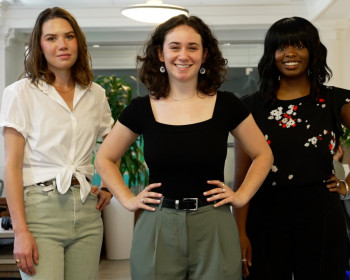Lewis & Clark set to expand environmental studies program and research with $600,000 grant
Open gallery

The Lewis & Clark Environmental Studies Program has earned its third grant in 11 years from the Andrew Mellon Foundation to expand the program, taking more students and faculty to locations around the world for research, and sharing its unique environmental studies model with peer institutions. The $600,000 grant will also fund the creation of a new faculty position to help meet growing demand in environmental studies.
“This year, Lewis & Clark will graduate its largest class in this environmental studies program, and more than one out of every 10 students who apply to Lewis & Clark indicate an interest in majoring in environmental studies,” said Jim Proctor, professor and director of environmental studies. “The reputation of our environmental studies program continues to grow, and so we’re thrilled for the opportunity to share our pedagogy and philosophy with peer institutions that are interested in breaking the mold on how best to prepare future scientists, scholars, advocates, policy makers, and environment stewards.”
Realizing a new model for environmental studies
Since the environmental studies program began in 1997, Lewis & Clark has been at the forefront of building and honing an interdisciplinary approach to environmental studies that uses situated research, a pedagogical framework that was integrated into the Environmental Studies Program with early support from the Mellon Foundation.
“Situated research offers a more concrete context for students to grasp the wide range of interdisciplinary connections in environmental studies,” Proctor said. “Rather than using a one-size-fits-all approach to a diverse world, situated research offers our students a connection with real-world, practical problems in their actual settings, providing students the opportunity to make a contribution to these problems.”
Emily Nguyen, a senior majoring in environmental studies, has been conducting situated research in a region of northern India where self-sufficient farming communities are rapidly disappearing. Nguyen is interested in capturing the disparities between what local citizens think about their region’s transformation and the reactions of outsiders. She said the Lewis & Clark Environmental Studies Program has helped her understand how communities with different cultures and values grapple with their environmental challenges and solutions.
“Based on my experience, situated research is a way of understanding environmental problems and solutions that occur in particular places,” Nguyen said. “It is a holistic analysis—at least as holistic of an attempt as possible—that grapples with all the social, economic, and ecological forces that converge and interact in these geographical places.”
In 2010, Lewis & Clark completed a three-year project funded by the Mellon Foundation that created direct and online collaboration between environmental program undergraduates across the country who adopted the situated research approach. The new grant will allow the college to share its model with a larger number of colleges through collaboration with the National Institute for Technology and Liberal Education (NITLE). Proctor and NITLE intend to tap technology for projects such as workshops on environmental studies technology and pedagogy, and real‐time student and/or faculty collaboration with partner environmental programs.
Supporting student and faculty research around the world
Currently, students can choose to conduct situated research during the fall or spring semester at 10 research sites spanning Ecuador, New Zealand, and India, as well as the Pacific Northwest. With the new grant, the Environmental Studies Program proposes an annual intensive summer overseas program in three new international locations tentatively identified as Japan, Swaziland, and Germany.
Offering students opportunities to do international research is an important part of preparing environmental studies majors, Proctor said.
“Our mission at Lewis & Clark is to train tomorrow’s thinkers and leaders to work effectively in an increasingly interconnected world. International situated research offers our students the opportunity to appreciate a variety of global contexts in which environmental problems and solutions unfold, and to more clearly articulate the international dimensions of domestic issues of concern to Americans.”
Nguyen said, through her own international research experiences, she has learned a lot about applying research methodologies she has learned in the classroom to faraway places.
“There is the obstacle of language and culture, but there are also methodological challenges, such as who to ask, whether their accounts are reliable and what to do with your data once you have collected it,” Nguyen said. “Many times, I have gone abroad with specific expectations and hypotheses only to come home with something entirely different.”
Read more about situated research being conducted by Nguyen and two of her peers, Kat Fiedler ’11 and Ben Mitzner ’11.
Public Relations is located in McAfee on the Undergraduate Campus.
MSC: 19
email public@lclark.edu
voice 503-768-7970
Public Relations
Lewis & Clark
615 S. Palatine Hill Road MSC 19
Portland OR 97219

